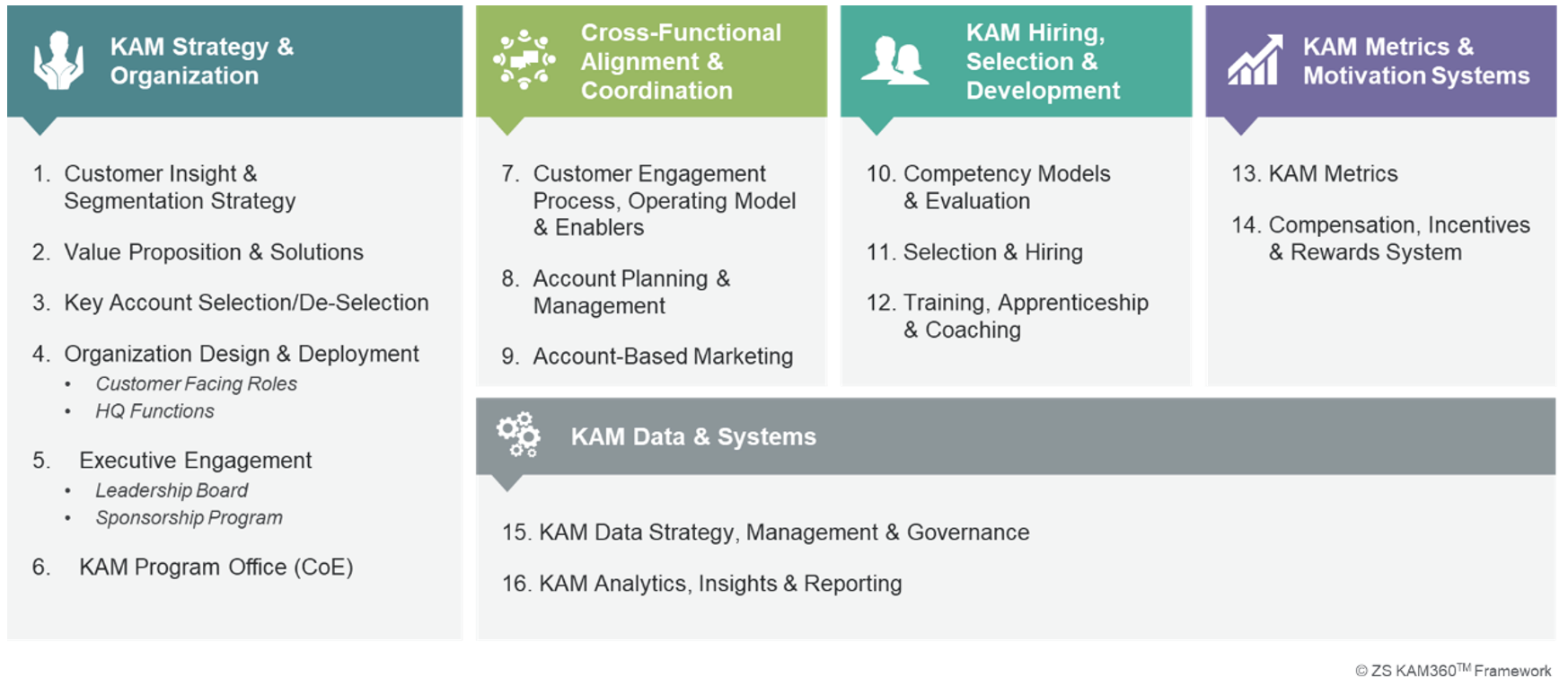Why Pharma Must Invest in Key Account Management Capabilities
The emergence of organized customers demands investment in advanced solutions and next-generation key account management.
The emergence of organized customers - large, sophisticated and complex healthcare provider and payer systems and groups with broad influence in the U.S. healthcare system - has sparked many trends, opportunities and imperatives for pharmaceutical companies. These fundamental changes in pharma’s customers had already increased the focus and prioritization of key account management (KAM) across the industry, but this focus was further reinforced by COVID-19. The pandemic not only accelerated these underlying trends, but also introduced a new one: the traditional lever of pharma promotion—the in-person sales representative—was scaled back. This has created even more urgency for pharma leaders to amplify their organizations’ KAM strategies and capabilities. The industry must invest in finding new and innovative solutions that go beyond the basic clinical features and benefits to address these organized customers’ needs and priorities. The industry must also invest in next-generation KAM resources and capabilities required to tailor advanced solutions, secure customer commitments and deliver on the value proposition. Companies that effectively do so will have an advantage over the playing field.
New research conducted by ZS and the Strategic Account Management Association (SAMA), “State of KAM in Pharma,” explores new opportunities, challenges and priorities for the pharma leaders responsible for their company’s organized customer strategy, capabilities and impact.
Research motivation and design
Organized customers—health systems, including integrated delivery networks, integrated payer and provider networks, national and regional payers, as well as large group practices—are becoming increasingly dominant in the healthcare system. Our research was driven by continuing healthcare trends that have profound implications for pharma organizations, such as:
- Increased consolidation and control: In Q3 2020, mergers and acquisitions activity remained strong despite the pandemic, with 19 announced transactions compared to 25 in Q3 2019. Pharmacy and Therapeutic committees (P&T) also continue to increase their influence; in a recent survey, 86% of integrated delivery network (IDN) administrators said they believe centralized decision-making through such bodies will increase.
- Cost management intensification: While provider organizations typically have modest margins of 3.5%, profits sank to the negatives in the second half of 2020. Further, IDN administrators indicate that care standardization such as physician scorecards will continue to influence prescribing. Of these IDN administrators, 30% stated that there’s a direct impact on prescribing decisions stemming from physician compensation.
- Business model innovation: Payers, providers and distributors are innovating their business models by creating new channels for healthcare delivery, with some investing billions into health technology, pre-acute care and new verticals. IDNs are also increasingly willing to take on risk.
While organized customers vary in terms of size, degree of integration, sophistication and the local healthcare markets in which they operate, they have some pivotal commonalities. According to another research study completed by ZS, the “Provider Organization Partnership Tracker Wave 3,” those include:
- A shift to systemwide decision-making for more formulary decisions
- Increased need and desire for external partnerships to achieve individual objectives relative to the quadruple aim
- Increased decision-making centralization to manage costs and improve care delivery
- Increased desire for risk-reward-based agreements with more manufacturers, such as outcome-based contracts
- Decreased access for typical pharma demand-generating roles
To shed additional light on the importance of KAM in the evolving healthcare system, ZS developed research on the state of KAM in pharma to explore the objectives, structure and operating models, support functions, effectiveness, barriers, metrics and investment priorities for pharma. Throughout the study, we defined KAM as an “organization wide business strategy” and researched 16 key drivers of KAM program effectiveness as defined by ZS’s KAM 360TM framework (see figure below).
KAM defined as an organization wide business strategy (ZS KAM360™)

Study participants included 17 KAM leaders representing enterprise or business unit KAM organizations at 10 top pharma companies, encompassing 24 total teams that engage with payers and/or providers. These companies represent half of the top 20 pharma companies and cover a breadth and depth of therapeutic areas. Data collection for the research occurred between the third and fourth quarter of 2020, with each of the 17 participating leaders taking a 45-minute online survey facilitated liveby a ZS business consultant.
Here are some key takeaways from our new report, “State of KAM in Pharma.”
Early progress, but room to grow
While pharma is still early in its journey to KAM, most companies aspire to build advanced KAM strategies and capabilities. Specifically, multiple KAM-related bright spots for the pharma industry include:
- For 15 out of the 16 key KAM drivers identified in the figure, we found that at least one participant in this study indicated their company was “highly effective” in that area. There were select examples of driver-specific best practices.
- Nearly all KAM leaders (16 of 17, or 94%) agree that the senior-most executives at their company consider KAM a strategic priority.
- Nearly all respondents conveyed the desire to evolve to next-generation KAM models that offer advanced solutions and value propositions to address a variety of organized customer needs.
Despite these encouraging signs, pharma companies still have significant work to do to evolve their KAM strategies and capabilities to ultimately maximize their impact and success with organized customers.
Address gaps in advanced solutions and value propositions
The development of advanced solutions and value propositions targeted to organized customers’ unique needs and priorities was the single highest investment priority for a majority of pharma companies—yet not a single company in our study reported having a high degree of effectiveness in it. In fact, a good portion of respondents (7 of 17) cited a low degree of effectiveness in this area, while 10 (60%) noted this as a key area of investment moving forward.
Additionally, 16 of the 24 teams represented in the survey (67%) noted the lack of compelling B2B solutions and value propositions is impeding organized customer impact. Furthermore, most said they struggle providing the right degree of KAM-specific marketing support and are more reliant on traditional brand and product marketing, which is highly ineffective with organized customers.
Further challenges for pharma include regulatory and compliance constraints, as it relates to value definition and strategy, as well as cross-functional collaboration—two critical components to successful KAM.
Cross-functional customer engagement and operating model clarity is essential
Half of surveyed leaders said significant investment in next-generation customer engagement processes and organization-wide operating models is critical to future success—the second-highest priority. A shift toward advanced solutions requires a well-defined customer engagement process, enabling the effective orchestration of customer-facing roles and swift alignment of internal functions that support and enable KAM. The customer engagement process and operating model are the foundation of any KAM program.
Regarding customer engagement and operating models, we also found that:
- A majority of KAM teams (16 of 24 or 67%) felt that KAM is not a well understood role within their company, especially for business unit-focused teams. Additionally, 50% noted internal role clarity and conflict as a major or moderate barrier.
- Almost half of pharma leaders (8 of 17) said the advanced customer engagement process and organization=wide operating model for key accounts is one of their top investment priorities.
- Only two leaders rated their organization’s ability to align internal support functions to enable KAM as highly effective.
- Only a third of pharma organizations have established a KAM program office or KAM center of excellence (COE) to drive KAM success, and most of this third have a relatively narrow scope of responsibility. Based on best practices from other industries, the development and expansion of KAM program offices and COEs in pharma present a significant opportunity.
Boost executive engagement now
We also found that:
- Two-thirds of our participants indicated that KAM will remain a strategic priority for their executive leadership, while a third said they face the risk of KAM becoming deprioritized.
- Most respondents (82%) indicated either a high or medium priority investment for KAM metrics, helping leadership better understand KAM account performance and KAM program impact.
- None of the KAM teams we surveyed run a formal executive sponsorship program out of their KAM program office or COE.
Pharma companies must improve executive engagement and support of KAM programs, given the immaturity of KAM within the industry. Doing so will help address several barriers facing KAM programs today, such as helping companies achieve alignment and coordination across the organization and overcoming a general lack of understanding regarding KAM as a business strategy.
Now is the time for pharma leaders to amplify their organizations’ KAM strategies and capabilities and develop organized-customer-focused solutions that tackle priorities beyond the base pharma products. This demands next generation value strategies, customer engagement models and key account manager skills and competencies. Above all else, pharma leaders must approach KAM as an organization-wide business strategy, and not as a sales initiative or role.
About the authors
Namita Powers is a principal in ZS’s Philadelphia office. She is the leader of ZS’s Healthcare Ecosystems practice area and helps life sciences companies design and implement organized customer strategy. Namita is an expert in commercial model strategy, design and effectiveness and has worked with Fortune 100 companies to evaluate and improve KAM program effectiveness.
Mike Moorman is a principal in ZS’s Chicago office and leads the firm’s key account management practice. Mike serves on the board of directors for the Strategic Account Management Association. Mike founded ZS’s B2B commercial strategy and transformation practice and has worked with more than 50 B2B organizations in more than 12 industries.
Alex Simon is a manager in ZS’s Evanston office and part of ZS’s KAM solutions team. Alex focuses on engagement and planning processes to help organizations become more effective and efficient with their KAM teams. Alex has supported KAM work across ZS’s pharmaceutical and medtech clients.
Left to right: Namita Powers, Mike Moorman, Alex Simon

The Misinformation Maze: Navigating Public Health in the Digital Age
March 11th 2025Jennifer Butler, chief commercial officer of Pleio, discusses misinformation's threat to public health, where patients are turning for trustworthy health information, the industry's pivot to peer-to-patient strategies to educate patients, and more.
Navigating Distrust: Pharma in the Age of Social Media
February 18th 2025Ian Baer, Founder and CEO of Sooth, discusses how the growing distrust in social media will impact industry marketing strategies and the relationships between pharmaceutical companies and the patients they aim to serve. He also explains dark social, how to combat misinformation, closing the trust gap, and more.